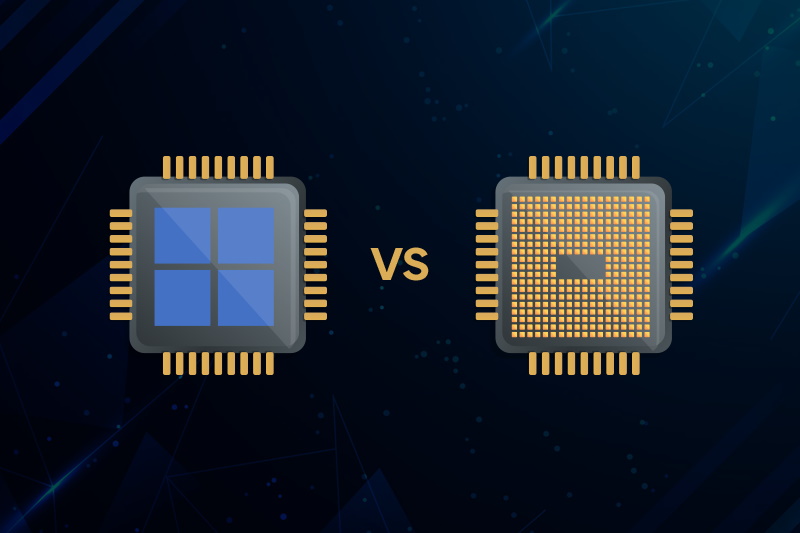To determine whether a CPU or GPU is more suitable for a specific task, you need to consider the nature of the task and the characteristics of both processors. Here are some steps to help you make the decision:
- Understand the Task Requirements: Determine the specific requirements of the task you need to perform. Consider factors such as the type of computations involved, the level of parallelism possible, the data size, and the software or libraries you’ll be using.
- Evaluate Parallelism: Assess the level of parallelism inherent in the task. If the task involves a high degree of parallel operations that can be divided into smaller, independent calculations, a GPU may be more suitable. On the other hand, if the task is more sequential in nature and requires complex decision-making, a CPU may be a better choice.
- Consider Software and Libraries: Check if the software or libraries you plan to use have GPU acceleration support. Some applications and frameworks are specifically optimized for GPU computing, while others may rely more on CPU performance. GPU-accelerated libraries, such as CUDA or OpenCL, can significantly enhance performance for certain tasks.
- Evaluate Memory Requirements: Consider the memory requirements of your task. GPUs typically have high memory bandwidth, which is beneficial for handling large amounts of data. If your task involves processing significant data sets, a GPU may provide an advantage. However, if the task relies heavily on frequent data access and manipulation, CPU cache performance may be more crucial.
- Assess Cost and Availability: Consider the cost and availability of CPUs and GPUs. GPUs can be more expensive than CPUs, and their availability may vary depending on the specific model and market demand. Additionally, factor in power consumption and cooling requirements, as GPUs tend to consume more power and generate more heat.
- Benchmark and Experiment: If possible, conduct benchmark tests or experiments to compare the performance of your task on both CPU and GPU. This can provide practical insights into which processor offers better performance and efficiency for your specific workload.
- Seek Expertise and Advice: Consult with experts or professionals in the field, such as developers or researchers with experience in your task domain. They can provide insights based on their expertise and help you make an informed decision.
CPU or GPU is more suitable for a specific task, you can consider the following factors:
- Task Type: Identify the nature of the task you need to perform. Is it a task that can be parallelized and involves a lot of repetitive calculations? Tasks like machine learning, data parallelism, video encoding/decoding, scientific simulations, and 3D rendering often benefit from GPU acceleration. On the other hand, tasks that require sequential processing, complex decision-making, or running a diverse range of applications may be better suited for CPUs.
- Software and Libraries: Check if the specific software or libraries you plan to use have built-in GPU support. Some applications and frameworks are optimized for GPU acceleration and can leverage the parallel processing power of GPUs. For example, popular machine learning frameworks like TensorFlow and PyTorch have GPU support that can significantly speed up training and inference tasks.
- Hardware Resources: Assess the available hardware resources. Determine the specifications of your CPU and GPU, including the number of cores, clock speed, memory capacity, and memory bandwidth. Compare these specifications to the requirements of your task. Consider the number of cores and their capabilities, as well as the memory bandwidth, as they can impact the performance of parallel tasks.
- Benchmarks and Performance Testing: Conduct benchmarks and performance tests to evaluate the performance of both CPU and GPU for your specific task. Run your task on both CPU and GPU configurations and measure the execution time or throughput. This will help you identify which processor delivers better performance for your workload.
- Cost Considerations: Take into account the cost implications. GPUs, especially high-end ones, can be more expensive than CPUs. Consider the total cost of ownership, including the initial investment, power consumption, and maintenance costs, when making your decision. If the performance gains provided by the GPU outweigh the additional costs, it may still be a worthwhile investment.
- Scalability and Future Requirements: Consider the scalability and future requirements of your task. If your workload is likely to increase in size or complexity over time, a GPU may offer better scalability due to its parallel processing capabilities. However, if your task is relatively small in scale or unlikely to require significant parallelism, a CPU might be more cost-effective and easier to manage.
Remember that the suitability of a CPU or GPU for a specific task depends on the characteristics of the task itself, the available software and libraries, and the specific hardware configurations. It’s important to carefully analyze these factors to choose the processor that best aligns with your performance, cost, and efficiency requirements.
SHARE
